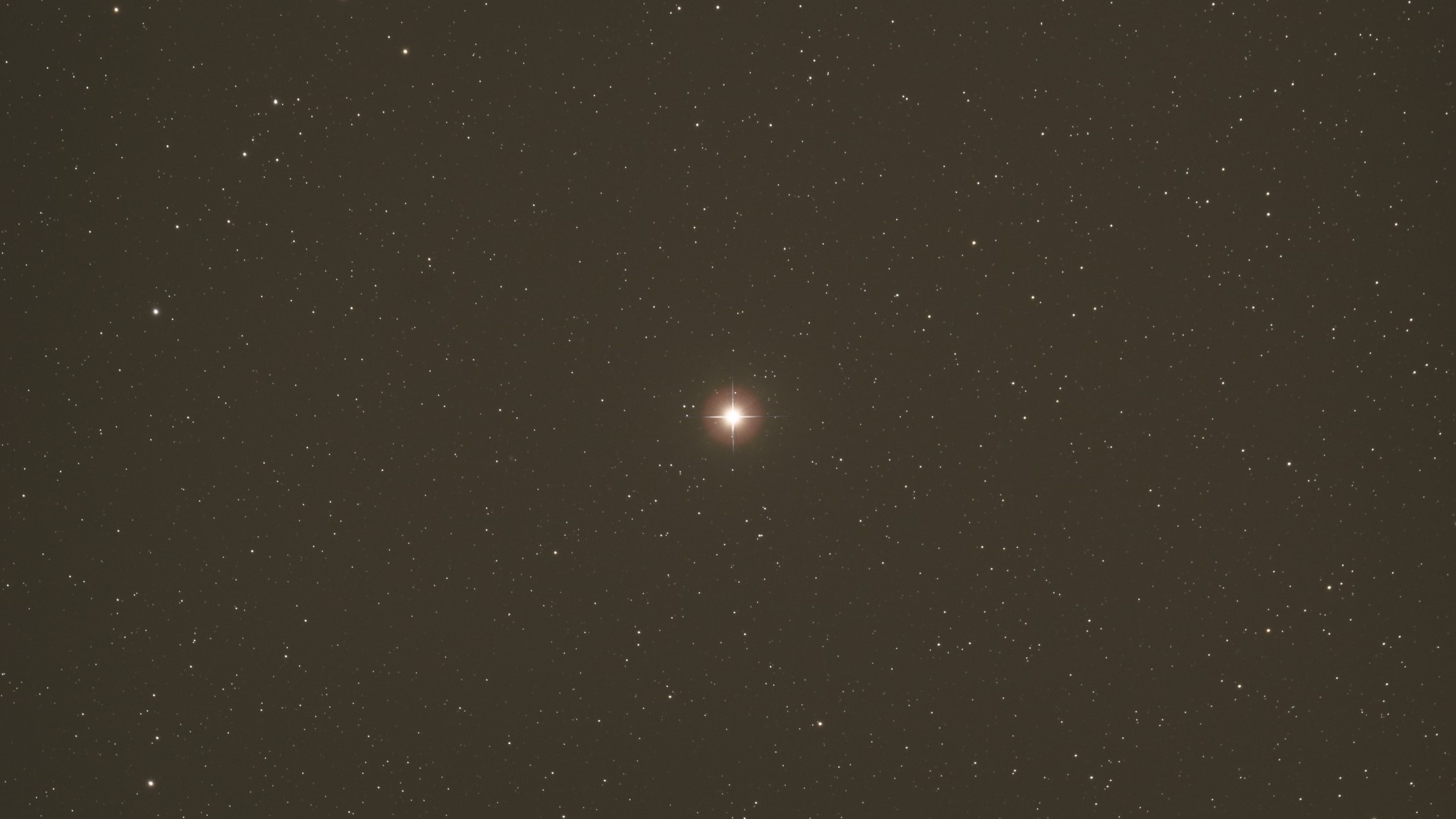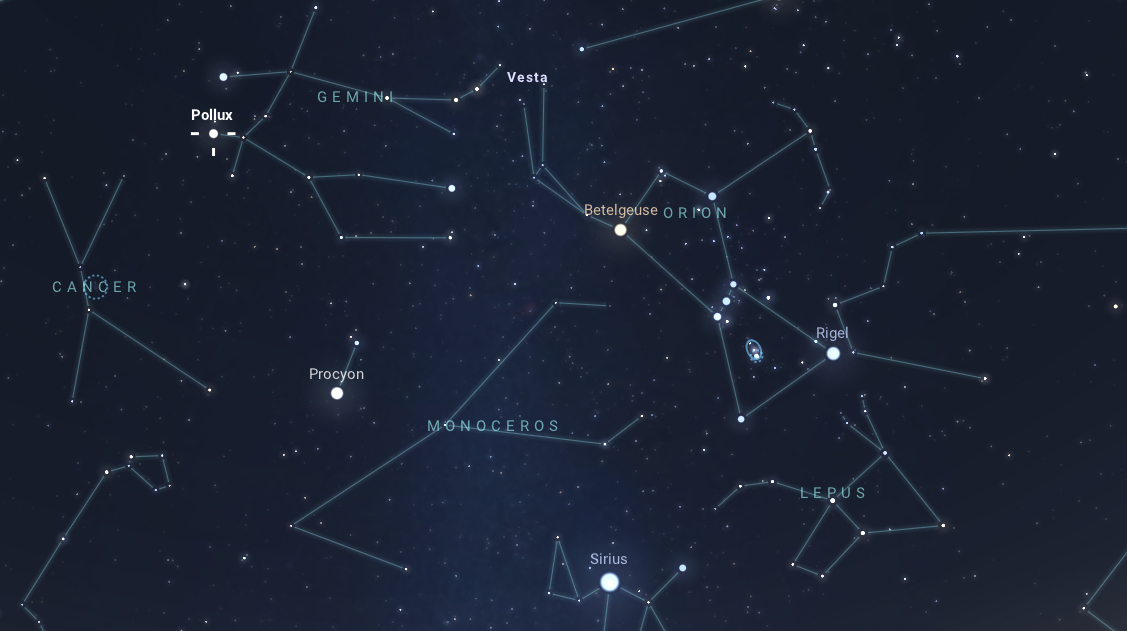Pollux, the brighter twin star of Gemini
Pollux is the brightest star in the constellation Gemini and one of the brightest stars in the night sky. Its intriguing features include a shockingly weak magnetic field and an orbiting exoplanet.

Pollux is the brightest star in the constellation Gemini.
It is also the 17th-brightest star in Earth's night sky, with a magnitude of about 1.16, Pollux is easily visible over Earth with the naked eye. Pollux is also known as HD 62509 in the Henry Draper (HD) star catalog and is located an estimated 34 light-years from the solar system.
Despite being the brightest star in Gemini, Pollux has the designation Beta Geminorum, with the "beta" prefix usually reserved for the second-brightest star in a constellation. In the case of Gemini, the name "Alpha Geminorum" was given to Pollux's twin star Castor, which is the second-brightest star in Gemini.
Related: The brightest stars in the sky: A guide
Pollux and Castor are referred to as twins because they make up the heads of the two stick figures in the constellation Gemini, taking their monikers from the mythological twins of the same name. Despite their proximity in Earth's sky, Pollux and the six stars in three binary systems that unite to form Castor are actually widely separated in the universe.
Pollux FAQs
Is Pollux bigger than the sun?
Yes, Pollux is far bigger than the sun. Pollux has nearly twice the mass of our star, and as a puffed-out hypergiant star, it is around nine times as wide. However, Pollux is not massive enough to go supernova. Like the sun, it will die as a white dwarf stellar core surrounded by shed outer layers.
What color is Pollux?
Pollux is a yellow-orange giant, officially classified as a K0 IIIb star. It is cooler, but brighter, than the sun.
Can we see Pollux from Earth?
Yes, we can see Pollux from Earth. In fact, with a magnitude of around 1.16, Pollux is visible with the naked eye. It is around the 17th-brightest star over Earth; it's slightly dimmer than Antares in the constellation Scorpius and brighter than Fomalhaut in Pisces.
What type of star is Pollux?
Pollux is a hypergiant star with an estimated mass of 1.9 times that of the sun, according to the University of Illinois at Urbana-Champaign. Although it has around twice the mass of the sun, Pollux is around nine times the width of our star.
Pollux is classified as a K0 IIIb spectral-type star, with the "b" indicating that it is less bright than average stars in this class. A light-yellow-orange star that is cooler than the sun, Pollux is estimated to have a surface temperature of 8,000 degrees Fahrenheit (4,400 degrees Celsius), compared with the sun's surface temperature of 10,000 F (5,500 C).
Despite its relative coolness, Pollux is around 45 times more luminous than the sun, meaning that if the two stars were located at the same distance from Earth, Pollux would be three times brighter than our star.
At around 725 million years old, Pollux is much younger than the 4.6 billion-year-old sun, according to the McDonald Observatory at the University of Texas. Despite its comparative youth, Pollux seems to have already left the so-called main sequence, the period of a star's life during which it burns hydrogen at its core to forge helium.
burnsIn 2009, astronomers discovered Pollux's magnetic-field strength is lower than 1 gauss — one of the weakest magnetic fields ever discovered around a star. For comparison, the sun's magnetic-field strength is around 10 gauss and Earth's is between 0.25 and 0.6 gauss.
Meet Thestias, the planet of Pollux
Since 1993, Pollux had been suspected to host a planet, and in 2006, astronomers confirmed that the star is indeed being orbited by an exoplanet.
The planet has a wealth of names, including Pollux b, HD 62509 b, Beta Geminorum b and Thestias. Its mass is around 2.3 times that of Jupiter, and its distance from Pollux is around 1.64 times the distance between Earth and the sun, with the planet taking around 590 Earth days to orbit its parent star.
Thestias was spotted via the radial velocity method of exoplanet detection, which looks at the tiny "wobble" a planet causes as it gravitationally tugs on its parent star.
Pollux in myth

Both Pollux and its twin star, Castor, take their names from half brothers in Greek and Roman mythology.
While Castor was the offspring of Leda, Queen of Sparta, and the mortal King Tyndareus, Pollux had divine heritage as a demigod born as a result of the coupling of Leda and the father of the gods, Zeus. Despite their differing parentage, the twins were said to have emerged from a single egg — the result of Zeus coming to Leda while disguised as a swan.
The twins, also known as the Dioscuri, shared an exceptional bond and together were responsible for the rescue of their sister Helen of Troy when she was kidnapped by a neighboring king, Theseus. They also appeared alongside other demigods, such as in Jason and the Argonauts' quest for the Golden Fleece.
In Greek mythology, when Castor was murdered by Idas and Lynceus, the ex-fiancés of the two women that Pollux and Castor planned to marry, the demigod's grief for his mortal half brother was so great that he pleaded with Zeus to allow him to share his immortality. This request was granted, and eventually, Zeus placed Pollux and Castor in the heavens as stars and an eternal representation of brotherly love.
The exoplanet Thestias also has a name derived from Greek mythology and a familial relationship to Castor and Pollux. The name Thestias derives from the grandfather of the twins in mythology, and it was selected for the exoplanet by citizen scientists from the Perth, Australia-based citizen astronomy project theSkyNet in 2015 via a competition run by the International Astronomical Union.
How to find Pollux in the night sky

Pollux is located in the constellation Gemini, the northernmost constellation of the zodiac, with a right ascension of 07h45m19s and a declination of +28°01'34", according to In-The-Sky.org.
Skywatchers can take a number of less direct routes to spot Pollux and Castor. One method is to locate the bright star Rigel at the bottom right of the constellation Orion. From there, you can trace an imaginary line up past Betelgeuse at the top left of Orion. Continuing past this line, Betelgeuse will lead between the heads of the twin stick figures of Gemini: Pollux and Castor.
Another way of locating Castor involves finding the Plough asterism in the constellation Ursa Major and using it as a signpost to the Gemini twin stars. Look at the "handle" stars of the Plough and then trace a line to the east, and you should land on the unmistakable pairing of Pollux and Castor at the eastern peak of Gemini.
Alternatively, you can find the stars that make up the horns of the constellation Taurus, particularly Aldebaran, and then trace an imaginary line from the horns that point at the bright celestial twins.
Additional resources
Pollux is one of the brightest stars in Earth's sky. Here are some of the others detailed by Michigan State University. Read more about the mythology of Pollux and Castor at Britannica. The radial velocity method was integral to the discovery of an exoplanet around Pollux. Read how it is done in this explainer from The Planetary Society.
Bibliography
Stars, University of Illinois at Urbana-Champaign http://stars.astro.illinois.edu/sow/sowlist.html
Moon and Pollux, Star Date, McDonald Observatory at the University of Texas https://stardate.org/radio/program/2023-10-06#:~:text=Pollux%20is%20only%20about%20725,their%20nuclear%20fuel%20more%20quickly.
Pollux - β Geminorum (beta Geminorum), The Sky Live, [Accessed 12/07/23], [https://theskylive.com/sky/stars/pollux-beta-geminorum-star]
Pollux, Britannica, [Accessed 12/01/23], [https://www.britannica.com/place/Pollux-star]
Join our Space Forums to keep talking space on the latest missions, night sky and more! And if you have a news tip, correction or comment, let us know at: community@space.com.
Get the Space.com Newsletter
Breaking space news, the latest updates on rocket launches, skywatching events and more!

Robert Lea is a science journalist in the U.K. whose articles have been published in Physics World, New Scientist, Astronomy Magazine, All About Space, Newsweek and ZME Science. He also writes about science communication for Elsevier and the European Journal of Physics. Rob holds a bachelor of science degree in physics and astronomy from the U.K.’s Open University. Follow him on Twitter @sciencef1rst.










